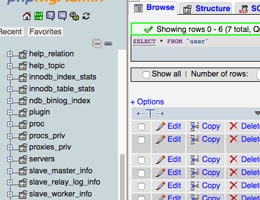 MySQL is the name of a system that allows database management . This is the most commonly used option for web- based applications.
MySQL is the name of a system that allows database management . This is the most commonly used option for web- based applications.
This relational database manager was created by the company MySQL AB . This company was purchased by Sun Microsystems in 2008 , which in turn was acquired by Oracle Corporation two years later. This means that today Oracle has the rights to most of the code, although MySQL has a dual license (it has a commercial license held by Oracle and another general public license).
The MySQL database is therefore distributed in different ways. There is a version with a general public license of GNU (the so-called Community Edition ) and others aimed at companies that provide additional services and products. It should be noted that Facebook , YouTube and Twitter , among other of the most visited websites in the world, work with MySQL .
GNU/Linux, macOS, SunOS, Solaris y diferentes versiones de Windows (Windows 7, Windows 10, Windows Vista y otras), entre muchas plataformas más, permiten el funcionamiento de MySQL.
It is important to mention that, as a relational database manager, MySQL offers flexibility and speed, since data is stored in separate tables that relate to each other, and not in a single large file. It is estimated that there are more than 6 million copies of MySQL currently in operation, demonstrating the enormous popularity of this system .
To a large extent, MySQL was developed using the C and C++ languages, which are also very popular, although there are currently many others that offer solutions tailored to the needs that have emerged in the world of computing. MySQL is among the four components of LAMP , a development package for Linux, and also in WAMP , for Windows.
Creating and managing a database in MySQL is not an extremely complex task, at least it cannot be compared to programming an application or a video game. However, if the volume of data is colossal and users have access to almost all of it, maintenance can be really difficult.
 Although we do not see it, MySQL is present in many of the activities we carry out daily on websites. For example, when we register, the data we enter in the forms goes through a validation process and is then recorded in such a database. When we search on YouTube, our line of text is checked against fields from the millions of videos stored in a MySQL database.
Although we do not see it, MySQL is present in many of the activities we carry out daily on websites. For example, when we register, the data we enter in the forms goes through a validation process and is then recorded in such a database. When we search on YouTube, our line of text is checked against fields from the millions of videos stored in a MySQL database.
To establish this connection between the content of a web page and that of a database, it is necessary to use intermediate programming languages , such as PHP and Javascript. For this reason it is normal that these two are added to HTML in the basic requirements of a web programmer. If it were not for such a combination, the Internet would remain a static space, where the content of each page would be created at the source and could not be altered by the user, something that happened in the early 90s.
Among the advantages of MySQL are the following:
* is free and free;
* the requirements for creating and using a database are relatively few;
* related to the previous point, it is not necessary to have a very powerful computer for normal databases;
* It is very fast and easy to use;
* supported by almost all operating systems ;
* the chances of data corruption are very low;
* It is very safe.
